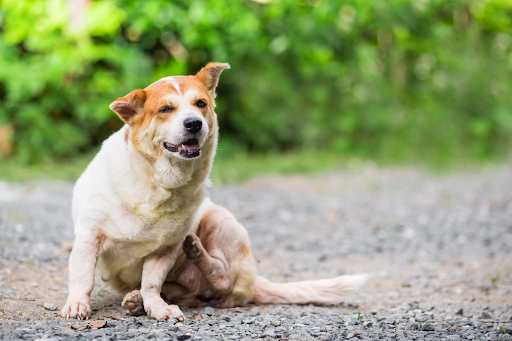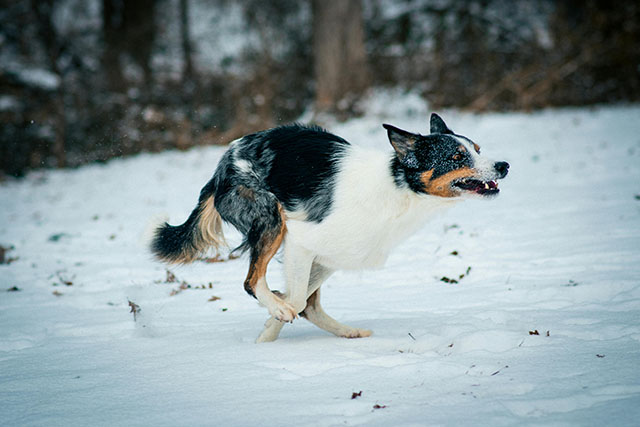As a pet parent, seeing your beloved pup suffer is one of the most difficult things you can go through. And if you notice signs of skin infection on your dog’s fur or body, it can be alarming and stressful. After all, finding any evidence that your pup is uncomfortable or unwell is always worrisome. But fear not!
In this blog post, we’ll provide you with an essential guide to spotting signs of common skin diseases in dogs — so you can recognize them early and take necessary steps to get your pup feeling better quickly.
How Do You Know if Your Dog Has a Skin Infection?
Visible Skin Changes
One of the most apparent signs of a skin infection in dogs is visible changes in their skin. Keep an eye out for:
- Redness: An inflamed or reddened area on your dog’s skin can indicate an issue.
- Rashes: Raised or bumpy rashes can be a sign of infection.
- Sores: Open sores that don’t seem to heal should raise concern.
Excessive Scratching and Licking
If your dog is constantly scratching, biting, or licking a specific area, it’s a strong indicator of discomfort caused by a skin issue. This behavior can lead to further irritation and potential infection.
Hair Loss
Unexplained hair loss or thinning can be a sign of an underlying skin problem. Pay attention to any bald spots or areas where your dog’s coat looks patchy.
Odor
Foul-smelling skin can be an indication of infection. If your dog’s skin emits an unpleasant odor, it’s time to investigate further.
Pus or Discharge
If you notice any discharge, such as pus or a watery substance, oozing from your dog’s skin, it’s crucial to seek veterinary care promptly.
Behavioral Changes
Sometimes, dogs with skin infections may exhibit behavioral changes such as restlessness, irritability, or a noticeable decrease in their activity level. This could be due to discomfort or pain.
What Causes Skin Infections in Dogs?
Understanding the underlying causes of skin infections is essential for both treatment and prevention. Here are some common culprits:
- Bacterial Infections: Bacterial skin infections in dogs can occur due to various factors, including cuts, scrapes, or allergies. The warm and moist environment created by a dog’s fur can promote bacterial growth.
- Fungal Infections: Fungi like yeast and dermatophytes can cause skin infections in dogs. Yeast infections are often associated with allergies, while dermatophytes can lead to ringworm, a contagious condition.
- Parasites: Fleas, ticks, mites, and lice can all infest your dog’s skin, leading to infections. These pests can irritate your dog’s skin, causing itching and discomfort.
- Underlying Health Conditions: Dogs with compromised immune systems or chronic illnesses, such as diabetes, are more susceptible to skin infections. Their weakened defenses make it easier for pathogens to take hold.
- Allergies: Allergies, whether food-related or environmental, can trigger skin problems in dogs. Common allergens include pollen, dust mites, and certain ingredients in dog food. For natural home remedies, check out this video:
How Do You Treat a Dog’s Skin Infection?
Once you’ve identified that your dog has a skin infection, it’s crucial to seek veterinary care for an accurate diagnosis and appropriate treatment. Here are common treatment approaches:
Medications
- Antibiotics: For bacterial infections, your vet may prescribe antibiotics.
- Antifungals: To combat fungal infections, antifungal medications are prescribed.
- Topical creams: These can help soothe and heal the affected area.
Medicated Baths
Medicated shampoos or baths can help cleanse the skin and alleviate symptoms. Consider trying Arava Natural Medicated Dog Shampoo. It provides relief from yeast and itching, promoting a healthy skin and coat. It also aids in healing hot spots, ringworm, scrapes, abrasions, and dermatologic infections. Available in a convenient 400ml / 13.5 fl oz size.
Allergy Management
If allergies are the underlying cause, your veterinarian may suggest allergy testing and management approaches. These may include dietary modifications or allergy shots.
Parasite Control
Maintaining good hygiene and preventing parasites is crucial for the well-being of your furry friend. Regular grooming and the use of flea and tick preventatives are essential. Keep your dog safeguarded from fleas and ticks with FRONTLINE Plus. This fast-acting, waterproof topical formula is proven to eliminate fleas, flea eggs, flea larvae, chewing lice, and ticks that can transmit Lyme disease. With 8 doses, it provides month-long protection to ensure your dog stays happy and healthy.
Pain Management
For discomfort and pain, your vet may recommend pain-relief medications.
Nutrition
Providing your dog with a well-balanced diet that encompasses essential nutrients is crucial to promote skin health and bolster their immune system. Consider trying Zesty Paws Multifunctional Bites, a premium 11-in-1 formula consisting of functional supplement chews. These chews are enriched with top-quality ingredients that support various aspects of your dog’s well-being, including joint health, antioxidants, heart function, immune system, skin health, liver function, and gut health. Suitable for dogs of all breeds and sizes, Zesty Paws Multifunctional Bites are designed to enhance physical performance and overall vitality.
How Do You Prevent Skin Infections in Dogs?
Prevention is often the best medicine when it comes to skin infections in dogs. Here are some proactive steps you can take:
- Regular Grooming
- Regular brushing and bathing can help keep your dog’s coat clean and free of debris that might cause irritation or infection.
- Parasite Control
- Use flea and tick preventatives as recommended by your vet.
- Check your dog for parasites regularly.
- Allergen Management
- Identify and minimize exposure to allergens that affect your dog.
- Consider hypoallergenic dog food if your pet has food allergies.
- Hygiene
- Keep your dog’s living area clean and dry.
- Wash their bedding and toys regularly.
- Balanced Diet
- Feed your dog a high-quality, balanced diet that supports their overall health and immune system.
- Regular Vet Visits
- Schedule routine check-ups with your veterinarian to catch and address potential skin issues early.
- Proper Exercise
- Ensure your dog gets enough exercise to maintain good circulation and overall health.
Final Thought
As pet parents, our dogs rely on us for their well-being. Being aware of the signs of skin infections, understanding their causes, and taking preventive measures can help keep your furry friend healthy and happy. Remember that if you suspect your dog has a skin infection, it’s essential to consult your veterinarian promptly for an accurate diagnosis and treatment plan.
By being proactive and attentive, you can provide the best possible care for your canine companion, ensuring many happy and itch-free years together.
Jessica is a veterinary medicine student who is passionate about animals. Living with her cherished dog, Milo, deepens her understanding of the human-animal connection, enhancing her empathy as a future veterinarian.
Jessica’s concise articles reflect her dedication to improving the lives of animals and those who care for them, making her an inspiring figure in the pet care field.







